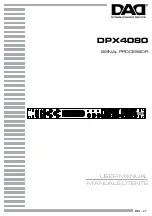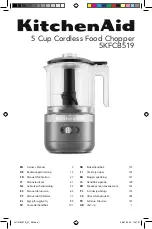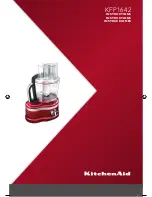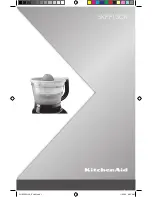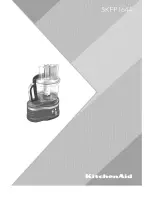
11
12
the remaining oil while the machine runs.
Process until all the oil has been added and the
mixture is totally emulsified. Remove from the
processor, cover and keep chilled until ready to
use. Homemade mayonnaise will keep in the
refrigerator for 3 to 4 days.
For a “one egg” batch of basic mayonnaise,
use ¼ cup (60 ml) of liquid pasteurized eggs,
2 tablespoons (30 ml) vinegar or lemon juice,
1 teaspoon (5 ml) dry mustard, ½ teaspoon
(2 ml) kosher salt and 1 cup (250 ml) vegetable
oil, such as canola oil. For variation, you may
experiment with using flavoured vinegars, or
adding chopped fresh herbs, or even roasted
garlic to taste. To make your mayonnaise a little
lighter, you may add some well-drained nonfat
plain yogurt to taste.
To beat egg whites:
The work bowl must be absolutely clean. Add
3 or more egg whites (up to 6 large egg whites)
and press the ON button. Add about 1 teaspoon
(5 ml) of lemon juice or vinegar for every egg
white. Vinegar makes stiffer whites; its flavour is
hardly detectable in cakes or soufflés. Continue
processing until the egg whites hold their shape,
about 1½ to 2½ minutes.
To whip cream:
Processor whipped cream holds its shape very
well. It is good for decoration or as a topping;
however, it will not whip to the light, fluffy
consistency obtained by methods that beat in
more air. Chill the cream well before starting.
Process continuously using the ON button,
until cream begins to thicken. Then add sugar
as desired and continue processing, watching
carefully for the desired consistency. For
consistently reliable results, add 2 tablespoons
(30 ml) of nonfat dry milk for every cup of cream
before whipping.
To make crumbs and crumb crusts:
Cut or break bread, crackers or cookies into
1-inch (2.5 cm) pieces and place in work bowl.
Press the ON button and process continuously
until crumbs reach the desired texture. For
seasoned crumbs, chop parsley or other fresh
herbs with the crumbs. For buttered crumbs,
process until the dry crumbs are of the desired
texture, then dribble melted butter through the
small feed tube opening while the machine is
running. For crumb crusts, process crackers or
cookies as described above. Add sugar, spices
and butter, and cut into pieces as specified by
your recipe. Process until well combined.
To make pastry:
Combine unbleached all-purpose flour, salt
and pieces of very cold butter in the work
bowl. Process to the consistency of cornmeal.
Sprinkle evenly with the minimum amount of
cold liquid in the recipe. PULSE 5 or 6 times.
The dough should begin to hold together when
pressed. If it is still dry and crumbly, add more
water – 1 teaspoon (5 ml) at a time – until the
dough holds together easily. Do not let the
dough form a ball in the processor or it will
be overworked and tough. Form into a round
disc, one-inch thick, and wrap in plastic wrap.
Refrigerate for 1 hour before using, or double
wrap and freeze for later use.
To make quick breads and cakes that use
baking powder and/or soda:
The most important rule for success is not to
overmix after adding the flour. The ingredients
for these soft doughs should be cold. If the
recipe calls for chopped ingredients like lemon
peel or nuts, chop them first while the work
bowl is clean and dry, then set aside until
needed.
Put dry ingredients like flour, salt and leavening
in the work bowl and process with the metal
blade for 5 seconds to mix. Remove and reserve
the dry ingredients.
Add the eggs and sugar to the work bowl and,
using the ON button, process to mix, letting the
machine run about 1 minute. Next, add butter,
cut into 1-inch (2.5 cm) pieces and at room
temperature. Run machine continuously for
a minute, until the butter is thoroughly mixed
with the sugar and eggs. Then add flavouring
and liquid – vanilla, spices, cocoa, etc. Process
until mixed. Add the dry ingredients to the work
bowl.
Process by pulsing, inspecting after each pulse.
Stop pulsing as soon as the dry ingredients
have almost disappeared into the batter.
Overprocessing will cause quick breads and
cakes to be tough. (If your recipe calls for
ingredients that are to be coarsely chopped
– like raisins or nuts – add them last with the
mixed dry ingredients.)
To make cake mix:
Your food processor work bowl is large enough
for the preparation of an 18.5-ounce (525 g)
packaged cake mix.
Insert the metal blade and add the cake mix to
the work bowl. Press the ON button and while
the machine is running, add the eggs and liquid
through the small feed tube and process for
5 seconds.
Scrape down the sides of the work bowl and
process 1 minute more for maximum volume.
Do not remove the metal blade.
Insert a finger into the underside of the blade
from the bottom of the work bowl, to hold the
blade in place while emptying the batter.
Tip:
After emptying cake batter or puréed soup from
the work bowl, replace the bowl on the motor
base and PULSE once. Centrifugal force will
spin the batter off the blade onto the sides of
the work bowl.
Remove the blade, and use a spatula to scrape
any remaining batter from the bowl.
PREPARING FOOD FOR
SLICING AND SHREDDING
For disc assembly instructions, refer to
Assembly Instructions on page 6.
Round fruits and vegetables:
Before processing onions, apples and other
large, round fruits and vegetables, cut the
bottom ends flat to make the food lie stable on
the disc.
Place the food in the feed tube, flat side down,
as far left as possible, to prevent it from tilting
when being processed.
Choose fruits that are firm and not too ripe.
Remove large hard pits and seeds from fruits
before processing. Seeds from citrus fruits need
not be removed. Remove the rind before slicing
or shredding, if desired.
Whole peppers are an exception:
Remove the stem and cut the stem end flat.
Remove the core and scoop out the seeds.
Leave the end opposite the stem whole, to
keep the structure stiff. This ensures round,
even slices.
Large fruits like pineapple:
Cut the ends flat, cut in half, and either core or
remove the seeds. If necessary, cut the halves
into smaller pieces to fit the feed tube.
Cabbage and iceberg lettuce:
Turn the head on its side and slice off the top
and bottom, leaving a center section about
3 inches (8 cm) deep. Remove the core, then
cut in wedges to fit the feed tube. Remove the
core from the bottom and top pieces and cut
into wedges to fit into the feed tube.
If the fruit or vegetable doesn’t fit, try inserting
it from the bottom of the feed tube, where the
opening is slightly larger.
Pack the feed tube for desired results:
For long slices or shreds, cut the food in feed
tube widths and pack the pieces horizontally.
For small, round slices or short shreds from
carrots, zucchini and other long vegetables, cut
into feed tube heights and pack tightly upright.
Food should fit snugly, but not so tightly that it
prevents the pusher from moving.
When slicing or shredding, always use
the pusher.
Never put your fingers or a spatula
into the feed tube.
Never push down hard on the pusher. Use
light pressure for soft fruits and vegetables
like bananas, mushrooms, strawberries and
tomatoes, and for all cheeses. Use medium
pressure for most food: apples, celery, citrus
fruit, potatoes and zucchini. Use firm pressure
for hard vegetables like carrots and yams.























